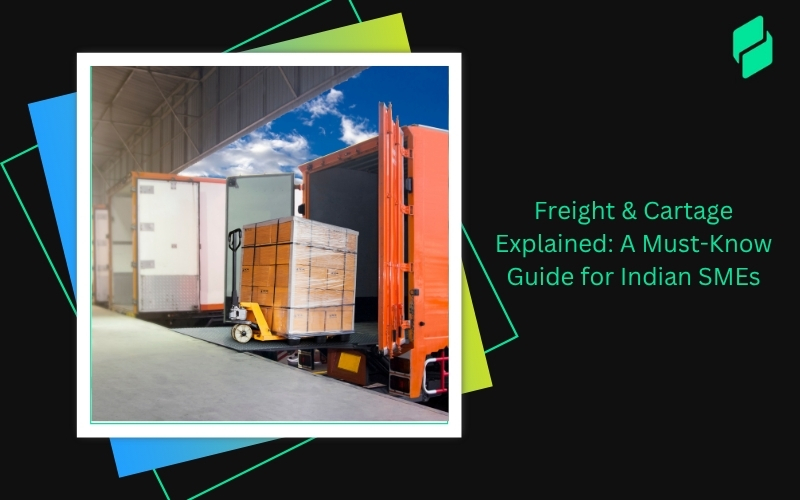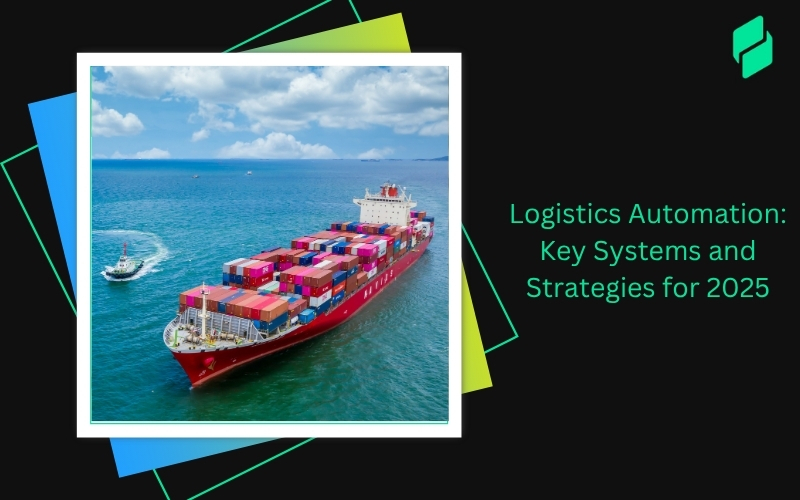Optimize your business: use unlimited savings with Pazago fulfilled now!
Get Started ->Did you know the global pharmaceutical industry was valued at around USD 1.6 trillion in 2023? And India's pharma sector plays a huge part, contributing over 20% of the global pharma supply chain! With such a massive footprint, disruptions in the supply chain can be a big deal, leading to delays, financial losses, and even penalties.
In a world where the pharma industry is constantly evolving, staying ahead of supply chain innovations is more than just an advantage. It's a necessity. From rising biologics demand to stricter regulations and digital shifts, the landscape is changing fast.
In this blog, we'll explore key trends like automation, sustainability, personalized medicine, and resilience. Understanding these changes can help you stay competitive and simplify operations. Let's start with understanding how automation and digital tools are improving logistics.
- Digitalization and Automation

Technology is reshaping pharmaceutical supply chains. AI, automation, and blockchain are making operations faster, smarter, and more reliable.
- AI and Machine Learning: Predicting demand is tough. AI analyzes real-time data to prevent stock shortages and overproduction. It also detects early signs of equipment failures, reducing downtime and unexpected disruptions.
- Robotic Process Automation (RPA): Manual tasks slow down operations. RPA automates invoicing, compliance checks, and shipment tracking, reducing errors and saving time. Automated systems ensure payments, orders, and shipments align, improving cash flow.
- Blockchain: Counterfeit drugs cost the industry $200 billion. Blockchain creates tamper-proof records of drug movements, making it easier to track shipments and verify authenticity. Smart contracts also simplify payments, reducing delays and disputes.
Also Read: Understanding a Digital Supply Chain Platform
- Cold Chain Advancements

Even a two-degree fluctuation can render vaccines or biologics useless. With mRNA vaccines and precision medicine on the rise, cold chain logistics must be smarter, faster, and more reliable.
Real-Time Monitoring
IoT-enabled temperature sensors now track shipments 24/7, instantly alerting handlers if conditions shift. AI-powered analytics predict risks, helping companies reroute or adjust cooling before damage occurs.
Sustainable Cold Chain
Traditional diesel-powered refrigeration is being replaced by:
- Solar-powered storage for lower energy costs.
- Phase-change materials (PCMs) instead of CO₂-heavy dry ice.
- Biodegradable insulation to reduce packaging waste.
Also Read: Understanding Different Types of Supply Chain Models
- Personalized Medicine and Direct-to-Patient Models

Pharmaceutical supply chains are shifting from mass production to patient-specific treatments. As demand for customized therapies and home-based care grows, supply chains must become more flexible and responsive.
On-Demand Manufacturing
Traditional drug production often leads to waste and delays. With personalized medicine, companies are moving toward small-batch, on-demand manufacturing.
- CAR-T cell therapy requires patient-specific drugs produced in specialized labs.
- 3D printing enables customized pill formulations based on individual health needs.
- Localized production units reduce lead times and cut excess inventory.
Direct-to-Patient Delivery
More patients now receive medications at home, increasing demand for secure, temperature-controlled last-mile logistics.
- Smart packaging tracks temperature and prevents tampering.
- Specialized courier services ensure regulatory compliance for home deliveries.
- Telemedicine integration simplifies prescription fulfillment.
Also Read: Understanding Last Mile Delivery in Logistics
- Supply Chain Resilience

Pharmaceutical supply chains are under constant threat from geopolitical tensions, raw material shortages, and regulatory changes. A single disruption can halt production and delay deliveries. To stay competitive, companies are reducing risks by diversifying suppliers, nearshoring production, and using AI for real-time risk management.
Diversifying Suppliers
Over-reliance on one country for APIs and raw materials creates major risks. Companies are now:
- Partnering with multiple suppliers across different regions.
- Investing in local API manufacturing to cut dependence on imports.
- Establishing regional distribution hubs for faster deliveries.
This shift benefits Indian exporters as global buyers look for alternatives to China.
Nearshoring
Instead of manufacturing in one central location, companies are setting up regional production hubs to reduce lead times. For example:
- U.S. firms are moving production to Mexico and Canada.
- European companies are shifting operations to Eastern Europe.
For Indian exporters, partnering with regional distributors can expand market access and improve supply chain agility.
AI-Driven Risk Management
Companies are using AI to predict disruptions by analyzing:
- Weather patterns for transport delays.
- Political instability for trade risks.
- Supplier reliability to detect shortages.
Companies that invest in resilience will secure stronger global trade partnerships and avoid disruptions.
Also Read: Understanding Nearshoring: Definition, Benefits and Strategies
- Sustainability and Circular Economy

Pharmaceutical supply chains are under pressure to cut waste, lower carbon emissions, and adopt eco-friendly practices. Regulatory bodies and global trade partners are demanding greener logistics, making sustainability a priority.
Green Logistics
Pharmaceutical shipments rely on air and ocean freight, both major carbon contributors. To reduce emissions, companies are adopting:
- Electric and hybrid delivery vehicles for short-haul transport.
- Biofuel-powered cargo ships to lower emissions.
AI-driven route optimization to cut fuel use and delivery times.
Waste Reduction
Pharmaceutical waste—expired drugs, overproduction, and excessive packaging—drives costs and environmental damage. Solutions include:
- Just-in-time (JIT) inventory systems to prevent overstocking.
- Recyclable and biodegradable packaging to reduce plastic waste.
- Reusable shipping containers for bulk transport.
Circular Supply Chains
More companies are shifting to circular supply chains, where materials are reused instead of discarded. Innovations include:
- Recyclable medical packaging to cut down plastic waste.
- Redesigning single-use devices with eco-friendly components.
- Repurposing unused medications where regulations allow.
As sustainability standards tighten, early adopters of green logistics will gain a competitive edge.
Also Read: Supply Chain Transparency Solutions and Platforms
- Regulatory and Compliance Innovations

Pharmaceutical supply chains face increasingly strict regulations to enhance drug safety, prevent counterfeiting, and improve transparency. Staying compliant is essential for maintaining global market access and avoiding costly disruptions.
Serialization and Track-and-Trace
The WHO estimates that in low- and middle-income countries, about 1 in 10 medical products is either counterfeit or of poor quality. To address this, governments are enforcing serialization and track-and-trace mandates, requiring:
- Unique serial numbers on every drug package for identification.
- Real-time tracking from manufacturing to delivery.
- Tamper-proof digital records to prevent fraud.
Regulations like the U.S. DSCSA and EU Falsified Medicines Directive mandate strict compliance. Non-compliance can result in shipment rejections and financial penalties.
Real-Time Monitoring
Regulatory bodies are pushing for automated monitoring systems to maintain product integrity. Key advancements include:
- IoT-enabled temperature tracking for biologics and vaccines.
- AI-powered compliance checks to flag potential violations.
- Blockchain documentation for secure, tamper-proof regulatory records.
As compliance rules tighten, pharmaceutical companies must adopt digital solutions to prevent delays, ensure quality, and maintain smooth international trade.
Also Read: Track and Trace Your Export Cargo
- Collaborative Ecosystems

Pharmaceutical supply chains are shifting from isolated operations to integrated ecosystems, where manufacturers, suppliers, logistics providers, and regulators collaborate in real-time. This shift is improving efficiency, reducing costs, and increasing transparency.
Partnerships and Alliances
Companies are forming strategic alliances with:
- Logistics providers for faster, more reliable transportation.
- Technology firms to integrate AI, IoT, and blockchain into operations.
- Regulatory agencies for smoother compliance management.
Many firms are now co-manufacturing APIs across multiple countries to avoid supply disruptions. Others are developing custom cold chain solutions with logistics partners to protect temperature-sensitive drugs.
Data Sharing Platforms
Fragmented supply chains lead to miscommunication and inefficiencies. Cloud-based data-sharing platforms allow stakeholders to:
- Access real-time shipment tracking and inventory updates.
- Monitor regulatory compliance across multiple markets.
- Share demand forecasts to prevent shortages and overproduction.
For example, Indian pharmaceutical exporters can use Pazago's communication platform to coordinate with overseas distributors, ensuring faster order fulfillment and proactive issue resolution.
Also Read: Understanding Supplier Relationship Management (SRM)
- Emerging Markets and Globalization

Pharmaceutical demand is rising rapidly in emerging markets such as Africa, Southeast Asia, Latin America, and the Middle East. These regions are increasing investments in healthcare infrastructure and medicine accessibility, creating new opportunities for global pharmaceutical trade.
Expansion into Developing Regions
Many developing countries face medicine shortages due to limited local production and high import costs. Governments are now encouraging pharmaceutical imports to improve drug availability. Indian exporters are well-positioned to fill supply gaps with affordable generic drugs, biologics, and APIs. However, entering these markets requires:
- Understanding local healthcare regulations and pricing strategies.
- Overcoming infrastructure barriers with efficient last-mile logistics.
- Adapting to digital pharmacy networks, such as mobile health platforms in Africa.
Global Standards
Regulatory inconsistencies have made pharmaceutical trade complex, but harmonization efforts are improving global accessibility. Initiatives such as:
- The African Medicines Agency (AMA): Facilitates drug regulations across Africa.
- ASEAN Harmonization Program: Aligns pharmaceutical approval processes in Southeast Asia.
- International Council for Harmonisation (ICH) guidelines: Set universal quality and safety standards.
Aligning with these standards will help reduce compliance barriers, accelerate approvals, and build trust with international buyers.
Also Read: India's Top Export Destinations and Trading Partners
- Patient-Centric Supply Chains

Pharmaceutical supply chains are evolving from bulk distribution to personalized delivery, driven by digital health, home-based care, and real-time data tracking. This shift demands faster, more responsive logistics that prioritize patient needs over traditional inventory models.
Real-Time Patient Feedback
Traditional supply chains operate on fixed-demand forecasts. Now, real-time data from pharmacies, digital health platforms, and patient feedback helps companies adjust production and distribution dynamically.
- AI-driven analytics predict demand fluctuations, preventing drug shortages.
- Prescription refill trends help manufacturers fine-tune inventory.
- Connected pharmacies and telehealth platforms provide real-time usage insights.
Digital Health Integration
With telemedicine and e-pharmacies expanding, medicine distribution is moving closer to the patient. This requires:
- Strong partnerships with online pharmacies for fast prescription fulfillment.
- Smart packaging with IoT tracking to monitor medication integrity.
- Optimized last-mile logistics, especially for temperature-sensitive drugs.
Specialty medications—like those for diabetes, cancer, or autoimmune diseases—require cold-chain precision, even for home deliveries. Companies investing in temperature-controlled last-mile solutions will stay ahead in this growing market.
Also Read: Understanding Last Mile Delivery in Logistics
- Advanced Analytics and Predictive Modeling

Pharmaceutical supply chains generate vast amounts of data, but without AI-driven analytics, much of it goes unused. Predictive modeling is transforming supply chains by enabling real-time decision-making, demand forecasting, and risk mitigation.
Demand Sensing
Balancing supply and demand is critical. AI-powered demand sensing analyzes real-time sales trends, external factors, and historical data to prevent overstocking and shortages. Automated inventory systems adjust stock levels dynamically, ensuring the right medicines reach the right markets on time.
Predictive Maintenance
Pharmaceutical production relies on cold storage units, transport fleets, and manufacturing equipment. IoT-enabled sensors and AI diagnostics detect early signs of mechanical failure, allowing companies to schedule repairs before breakdowns occur. This prevents costly disruptions and protects product integrity.
By integrating advanced analytics, pharmaceutical companies can optimize inventory, reduce waste, and improve supply chain efficiency.
Also Read: Supply Chain Assessment Tool - Pazago Insights
- Cybersecurity and Data Protection

As pharmaceutical supply chains become more digital, they also become prime targets for cyberattacks. Automated tracking, blockchain compliance, and AI-driven analytics produce large amounts of sensitive data, making data security more important than ever.
Secure Supply Chains
Pharmaceutical companies handle high-value information, including:
- Drug formulations and research data targeted by corporate espionage.
- Patient records from digital health platforms and clinical trials.
- Logistics data on shipments and inventory, vulnerable to cyber sabotage.
A single breach can lead to counterfeit drugs entering the supply chain, regulatory penalties, and business losses. Ransomware attacks have already disrupted pharmaceutical operations worldwide, delaying drug deliveries and impacting patient care.
Compliance with Data Privacy Laws
Governments are enforcing strict data protection laws such as:
- GDPR (Europe): Regulating the storage and transfer of patient data.
- HIPAA (U.S.): Ensuring security for health records.
- Data localization laws (India, China, etc.): Restricting how companies handle local data.
Staying competitive in a changing landscape requires more than just awareness. It demands smart execution. Here's how Pazago can help.
Also Read: Next-Gen SaaS Ship Management Software
Stay Competitive with Pazago

Managing global pharmaceutical logistics is complex. High shipping costs, compliance risks, and shipment delays can hurt business operations. Pazago simplifies supply chain management for Indian exporters and SMEs by offering smarter, faster, and cost-effective solutions.
Key Benefits of Pazago:
- Compare & Book Shipping: Choose from multiple trusted carriers for ocean freight and door-to-door transport to ensure your shipment is delivered efficiently and at the best price.
- Automated Documentation: Effortlessly generate and organize export documents while ensuring easy access to all necessary paperwork for smooth and compliant shipments.
- Real-Time Tracking: Track your shipments 24/7 to stay updated, identify potential delays, and take immediate action to ensure timely delivery.
- Centralized Communication: Collaborate with suppliers and logistics partners all in one place, improving communication efficiency and reducing response times.
- Quality Inspections: Schedule pre-shipment inspections to ensure your products meet required standards and access detailed reports for quality assurance.
- Insurance & Financing: Secure your shipments with trusted insurance options and simplify payments with integrated trade finance tools, offering full protection and ease of transaction.
Why It Matters for Indian Exporters
With growing regulatory demands and global competition, Pazago helps businesses cut costs, improve compliance, and enhance supply chain efficiency. By integrating digital logistics solutions, Indian exporters can expand faster and reduce trade risks.
Conclusion
The pharmaceutical supply chain is changing faster than ever. AI, automation, cold chain advancements, and personalized medicine are reshaping global trade, while regulatory shifts, sustainability goals, and cybersecurity threats demand smarter strategies. Indian exporters and SMEs that adapt early, invest in digital tools, and strengthen supply chain resilience will gain a competitive edge in global markets.
Efficiency, compliance, and visibility are no longer optional, they are essential for survival. Pazago simplifies supply chain operations by helping businesses find the best shipping rates, automate documentation, track shipments in real time, and manage compliance with ease. If you're looking to expand globally without the logistical headaches, it's time to make your supply chain smarter with Pazago.
Global reach, zero friction. Discover how Pazago simplifies pharmaceutical logistics so you can focus on growth, not red tape. Schedule a demo and experience the difference.


.png)








